Get started planning an ESG Program in your Organization
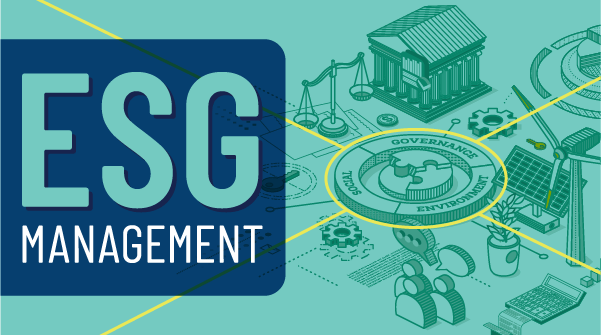
Whether your organization is in the early, middle, or late stages of an ESG program, a repeatable tracking and compliance process is key for success. This article outlines recommended steps for any organization looking to start an organized and scalable ESG program.
The Importance of ESG
The movement behind more environmentally friendly and socially conscious businesses stems from recent cultural changes in nations around the globe. Some describe this change in consumerism as a ‘populous becoming woke.’ Consumer values have shifted to emphasize environmental sustainability, gender equity, climate protection, diversity, and inclusion.
More than just media hyperbole or political rhetoric, consumers are now voting with their dollars. Investors can now contribute and buy into ESG-specific investment funds, which were quickly established by some of Wall Street’s most notable financial players like PIMCO, BlackRock, and Vanguard.
Businesses wanting to prove their financial value—not just their cultural value— have begun implementing ESG programs. These environmental, social and governance improvement plans not only to impact an organization’s ability to hire and retain top talent, but also grow its customer base and provide greater returns for shareholders.
How Organizations are Implementing ESG
When businesses first started adopting ESG there was no official regulation, standard of approval, or formula to guide their ESG program. As a result, many businesses built their own programs that benchmark their performance across several pillars or focus areas of ESG and then implemented improvement plans to raise their ratings year-over-year.
To effectively launch an ESG program, a business needs to identify an ESG program owner within the organization who will run point as the ESG leader. That ESG program leader will manage the governing principles, testing, and performance reporting for a multi-year process.
Planning an ESG Roadmap
If you’re thinking about getting started or need a few pieces of advice to move faster, take advantage of the free planning tools below.
Step 1: Assign an ESG Owner
This individual’s role is to guide and manage the overall ESG program. His or her leadership aligns the business to which governing ESG principles the organization will adhere, as well as oversee performance evaluations and improvement plans when needed. It’s important to note that in some organizations, this role could simply be the leader, not the executioner of testing and improving. For smaller businesses, it is common for this role to be responsible for everything ESG, including execution.
We’ve seen some organizations identify ESG owners from compliance, legal, and risk management functions. You can learn more about this type of ESG leadership approach from Sevita, a home and community-based healthcare organization, who built out a custom ESG program to fit their goals.
Regardless of which originating team your ESG program owner aligns with, the importance resides in his or her skillsets to manage ESG program communication, oversight, and follow-up.
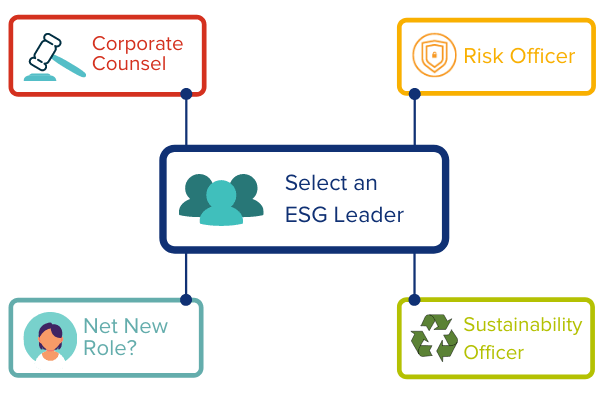
Step 2: Identify ESG Governing Factors
The next step is to decide as an organization which ESG program criteria your organization will align to and govern itself against. Remember, these are self-identified ESG program factors, not compliance-mandated regulations, or frameworks. Consider these criteria the core, fundamental principles behind ESG that are important to your business. Each core ESG program principle will likely contain a spiderweb of related elements within.
Example ESG program principles:
- Accelerate Decarbonization
- Community Involvement
- Corporate Governance
- Diversity & Inclusion
- Employment Practices
- Health & Safety
- Employment Practices
- Executive Compensation
- Environmental Footprint
- Raw Materials Sourcing
Define what each ESG program principle means to your organization and establish examples of what success means. These examples will form the basis of your ongoing ESG program self-assessments to measure performance.
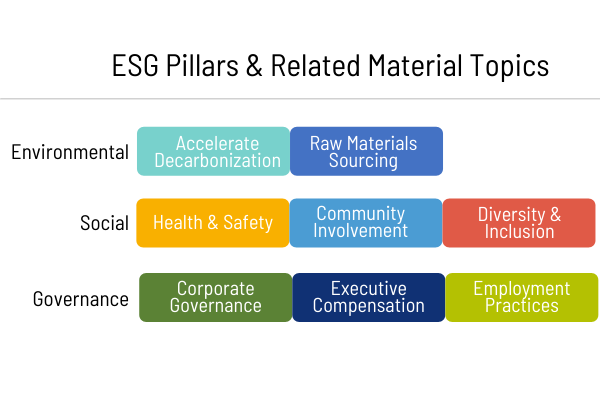
Step 3: Design an ESG Self-assessment
To evaluate the performance of your organization’s ESG program, you’ll need to create a scalable and quantifiable method to measure success or continual improvement.
Using the ESG program principles documented in step two, create a list of questions that can be used in assessments or evaluations by multiple members of your organization. To develop the list of ESG program evaluation questions, think through the following:
- Process: What processes does our organization have in place now to enable this principle?
- Policies: What policies have we documented and communicated to establish our stance on this principle?
- Practices: What practices do our employees follow that support this principle?
- KPIs: How can we measure effectiveness in this principle?
- Review: How often should we review our processes, policies, practices, and KPIs to ensure we adequately enable this principle?
As you go through the process to develop assessment questions, remember the purpose is to establish a defined method to evaluate your own ESG program performance against defined criteria. Assessment questions could offer simple yes or no answers to the assessor, whereas it might be more valuable to provide a sliding scale matrix to evaluate performance. Often, there are gray areas when it comes to matters of ESG.
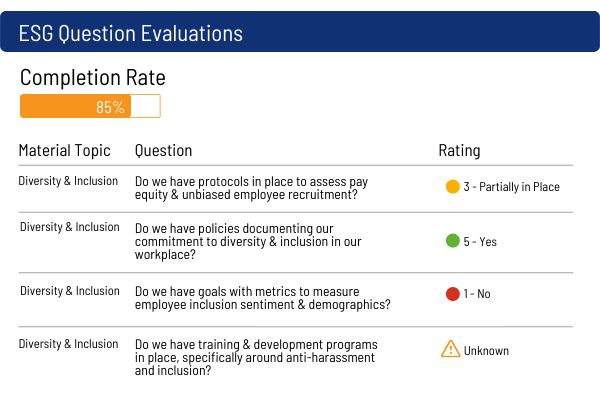
Example assessment questions:
Diversity & Inclusion
- Do we have protocols to assess pay equity and unbiased employee recruitment?
- Do we have training and development programs in place, specifically around anti-harassment and inclusion?
- Do we have goals with metrics to measure employee inclusion sentiment and employee demographics?
Employment Practices
- Are we practicing emergency response plans?
- Do we have stocked first aid stations in our operations centers?
- Are we engaging with our workers’ trade unions?
Health & Safety
- Do we know our environmental health and safety-related risks to our operations centers?
- Have we prioritized operations centers with increased levels of health and safety risk-based geography?
- Have we updated safety practices and procedures?
Step 4: Build Corrective Actions
After you have designed your list of ESG program assessment questions, you’ll need to establish a rubric for completed evaluations. This means you’ll need to denote the implications of each answer.
For example, should a “no” answer or a sliding scale answer below a “5” be marked as non-compliant to your ESG program? Understanding upfront the potential implications of assessment results is just as important as the assessment questions themselves.
Well-orchestrated ESG programs include real-time follow-up for non-compliant issues. Many organizations use an automated program like Onspring to conduct follow-up remediation activities.
In doing so, an ESG program owner can proactively assign tasks to individual team members based on their subject matter expertise. This automated process creates expedited improvements without creating bottlenecks.
Example corrective action:
A “no” response to “Have we updated safety practices and procedures?” in an ESG program assessment would flag this line item as non-compliant and follow up with a task to the appropriate team member responsible for revisiting their existing policies.
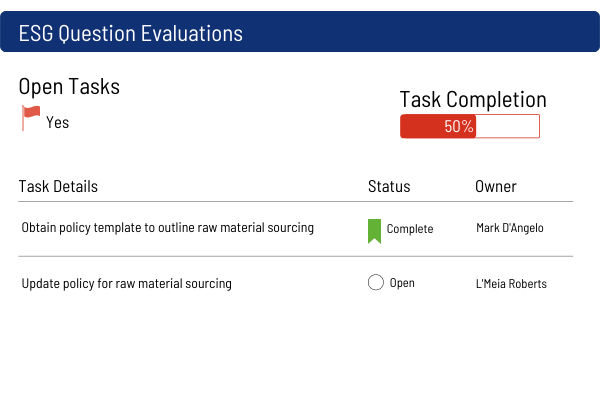
Step 5: Conduct a Benchmark ESG Self-assessment
Once your organization has established its ESG program evaluation, proceed with conducting a self-assessment to use as a benchmark. You can execute a self-assessment in the form of a survey, but we recommend utilizing an Onspring app to automatically schedule your assessment and automatically populate results into real-time reporting that can be shared with both executives and your board. Learn more about real-time reporting & automated assessments in Onspring’s pre-built ESG program.
The initial findings from your first self-assessment will deliver the benchmark metrics to evaluate your ESG program against for the next year. Annual internal ESG program assessments are recommended for businesses as they provide enough time for your organization to make substantial improvements against your self-defined ESG program principles.
Keeping your benchmark report referenceable to the board, executives and business owners is a key element in continuing to improve your ESG program.
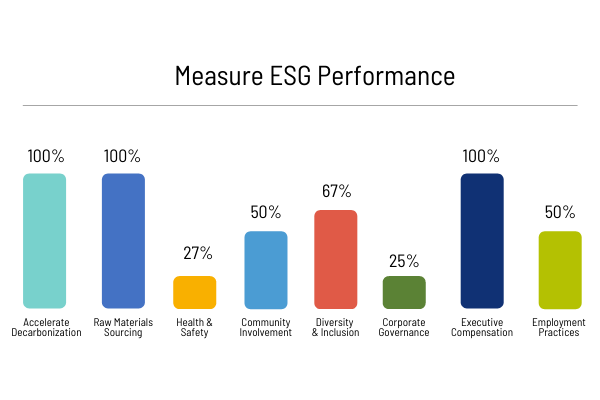
ESG Program Assessment Findings
The results of your first self-assessment are not just for benchmarking, they are also for taking action to improve business policies, practices, and processes as you strive to become a best-in-class ESG organization. Continue to re-evaluate your ESG program year-over-year to improve.
If you need help designing your ESG program or creating a method to track, deploy, and measure compliance, take a look at the ESG Management Solution in Onspring. This pre-built ESG program can get you moving in a day, while still allowing you complete flexibility to customize any process, report, and more all on your own.


